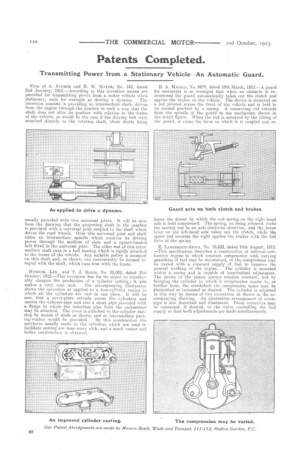Patents Completed.
Page 26

If you've noticed an error in this article please click here to report it so we can fix it.
Firm of A. SAURER and H. M. MAYER, No. 143, dated 2nd January, 1913.—According to this invention means are provided for transmitting power from a motor vehicle when
stationary, such for example as driving a dynamo. The invention consists in providing an intermediate shaft, driven from the engine through the gearbox in such a way that the shaft does not alter its position with relation to the frame of the vehicle, as would be the ease if the driving belt were attached directly to the rotating shaft, these shafts being usually provided with two universal joints. It will be seen from the drawing that the projecting shaft in the gearbox is provided with a universal joint coupled to the shaft which drives the road wheels. Over this universal joint and shaft slides an intermediate spindle which receives its driving power through the medium of slots and a square-headed bolt fitted in the universal joint. The other end of this intermediate shaft runs in a ball bearing which is rigidly attached to the frame of the vehicle. Any suitable pulley is mounted on this shaft and, as shown, can conveniently be formed integral with the shaft, which runs true with the frame.
HUMBER, LTD., and T. J. Blocs, No. 25,002, dated 31st October, 1912.—This invention has for its object to considerably cheapen the production of a cylinder casting ; it also makes a very neat unit. The accompanying illustration shows the invention as applied to a four-cylinder engine in which all the cylinders are cast in one piece. It will be seen that a cover-plate extends acmes the cylinders and carries the exhaust-pipe and also a short pipe provided with a flange to which the induction pipe from the carburetter may be attached. The cover is attached to the cylinder castting by means of studs as shown, and an intermediate packing-washer would be provided. By this construction the apertures usually made in the cylinders which are used to facilitate casting are done away with, and a much neater and better construction is obtained. R. A. MAGILL, No. 6677, dated 18th March, 1913.—A guard for motorcars is so arranged that when an obstacle is encountered the guard automatically takes out the clutch and applies the brakes on the vehicle. The device is mounted on a rod pivoted across the front of the vehicle and is held in its normal position by a spring. A connecting rod extends from the spindle of the guard to the mechanism shown in the detail figure. When the rod is actuated by the tilting of the guard, it rocks the lever to which it is coupled and re
leases the detent by which the coil spring on the right-hand side is held compressed. The spring, on being released, rocks the central rod in an anti-clockwise direction, and the lower lever on the left-hand side takes out the clutch, while the upper rod towards the right applies the brakes with the full force of the spring.
E. LANZEROTTI-SPINA, No. 18,623, dated 14th August, 1912. —This specification describes a construction of internal-combustion engine in which constant compression with varying quantities of fuel may be maintained, or the compression may be varied with a constant supply of fuel to improve the general working of the engine. The cylinder is mounted within a casing and is capable of longitudinal adjustment. The stroke of the piston always remains constant, but by bringing the cylinder in which it reciprocates nearer to, or further from, the crankshaft the compression space may be diminished or increased as desired. The cylinder is adjusted in this way by means of two eccentrics, as shown in the accompanying drawing. An alternative arrangement of eccentrics is also described and illustrated. These eccentrics may be connected, if desired, to the valve controlling the fuel supply so that both adjustments are made simultaneously.


























